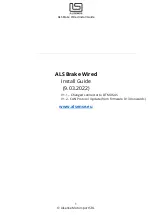
ALS Brake Wired Install Guide
9
© Alsense Motorsport SRL
Always use twisted paired cable for CAN Low and CAN High wiring as it greatly improves the
signal’s tolerance to electrical noise. Also try and keep wiring stubs (cables going from the main
CAN bus lines to individual devices) at a minimum. Our sensors come with a 0.5m cable, it’s
generally ok to have another 0.5m in addition to that.
5.
Configuration
If you haven’t requested a custom configuration for the sensors in your order, the
default
settings are as follows, along with a short description of what their function is:
Parameter
Default Value
Function
CAN Base ID
0x400 (for a one sensor order)
– Front Left
0x420 – Front Right
0x440 – Rear Left
0x460 – Rear Right
Base CAN ID for all messages
sent from the sensor
Emissivity
0.83
Lowering the emissivity
increases the brake
temperature. Suggested values
depend on the brake disc
material.
Sample Rate
20 Hz
Sampling and reporting rate
for the sensor
Number of Channels
16
Number of channels used for
sampling
Sensor Data Order
Left to Right
[Figure 1]
Channel numbering direction
when looking at the sensor’s
camera
CAN Bit Rate
500 kbps
Initial Configuration Delay
60 seconds
The delay, in seconds, between
the sensor powering up and it
starting to send temperature
data over CAN. This is when
new configuration parameters


















